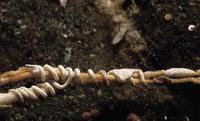WORM TUBES AND OTHER VERMIFORMS
Periodically the observant beachcomber or diver may encounter a small tubular structure that has been produced by an unknown Pacific Northwest organism. Whether empty or occupied by a secondary tenant, the original “builder’s” identity is often a mystery. The assumption that some species of an annelid worm is responsible might not be correct, as other marine creatures also create tubes. These four photographs illustrate this phenomenon.

|
This photograph shows a thin-bored tubular structure coiled around the central stem of a hydroid. Its contents were examined and nothing was revealed to suggest that it was a polychaete’s tube or even some form of “egg case” produced by another marine organism. There are many unusual forms in the benthic marine environment that are still unknown or have an unresolved identity. This appears to be one of them. |
Since publication of this volume, we have determined that the “worm segment” featured under “Photograph D” is the rear segment (of three) from a species of U-SHAPED PARCHMENT TUBEWORM Chaetopterus sp. appearing as AN81. When this worm is disturbed or stressed it can break apart, with the rear portion acting as a wriggling diversion to potential predators while the forward portion crawls away to regenerate into a complete specimen and ultimately secrete a new tube. We thank Leslie Harris of the California Academy of Science for this impressive sleuthing.
